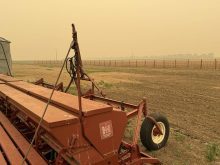The central goal of the federal government’s “made-in-Canada” BSE program – increasing domestic packing capacity to reduce reliance on live exports – is in jeopardy because of a poorly designed support plan that lenders will not accept, critics complained last week.
Federal agriculture minister Andy Mitchell immediately said he will amend the rules if needed, although he added it is too early to judge it a failure because Treasury Board hasn’t even approved the money yet.
“Final Treasury Board approvals are just occurring now on the parameters of the program so I don’t think there has been an opportunity yet to judge the effectiveness of it,” Mitchell said about the program announced Sept. 10.
Read Also

Saskatchewan puts crown land auction on hold
Auctions of Saskatchewan crown lease land are once again on hold.
“We put forward what we believe is a good plan and one we believe is workable. If we find that it needs to be refined, then we’ll do the refining we need to do.”
Inside the Commons, criticism of the government plan was relentless.
Conservative Rick Casson of Lethbridge, representing the heart of Alberta’s feedlot industry, said the government’s $38 million loan-loss program to encourage new construction is not doing the job and if new construction does not start this autumn before the winter freeze, the entire federal plan is ineffective.
“The idea of a set-aside program is absolute folly if there is not increased capacity or if the border is not open when that set-aside program ends,” he said.
In a later interview, Casson said the lack of rules and lack of money for the loan-loss reserve means bankers are not willing to advance money and the entire push to expand capacity is on hold.
“We do not have a lot of time and bankers simply aren’t willing to use this promised program as a basis for lending,” said Casson.
“I know people who want to start but can’t. If things don’t start happening within days, this strategy is in trouble.”
Edmonton Liberal and agriculture committee member David Kilgour said the government must change the loan-loss program if the “made-in-Canada” strategy is to be salvaged.
“I have talked to a potential builder and he says the bank won’t touch it,” Kilgour said in an interview.
“They think it is bureaucratic and they have told him they will have nothing to do with it. It has to be changed and we’ve communicated that to the minister but until it is changed, everything is on hold.”
In the Commons, Kilgour said lenders believe the program of government guarantees will leave them with a 60 percent liability for losses on loans that they deem to be high risk.
If the rules are not changed quickly and money made available for loan loss, “very little if any new slaughter capacity will come on line to absorb the glut … and a lot of money will simply go to waste.”
The blunt criticism of government BSE plans and the emergency debate marked the start of the new Parliament and the first minority government in a quarter century. Agricultural issues were front and centre.
In the throne speech outlining government priorities Oct. 5, agriculture and BSE received barely a mention.
But the strengthened opposition quickly filled in the gap, demanding and receiving an emergency debate on BSE that started Oct. 7 in the evening and was to pick up again this week because of the MP demand for speaking time.
Agriculture featured in the first question period and opposition leader Stephen Harper spent considerable time complaining about government inaction on BSE but also the general farm income crisis.
“In yesterday’s speech, the government almost completely ignored Canada’s farmers and rural Canada generally,” he said.
“The BSE crisis is one of the greatest crises ever faced by our agricultural sector but BSE is not the only problem faced by our agricultural sector …. Federal support and relief programs do not seem to be working.”
He has assigned Conservative agriculture critic Diane Finley the job of touring the country to find out what type of agriculture policy is needed to put the industry back on its feet.
















